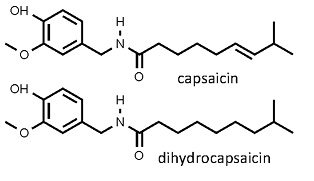 Capsicum annuum
Capsicum annuum
paprika • chilli • cayenne pepper
Back to “Salad herbs and herb mixtures: green pepper, sweet pepper (Capsicum annuum); sweet pepper (Capsicum annuum)”
Back to “Spices: cayenne pepper (Capsicum annuum, C. frutescens)fr; paprika (Capsicum annuum)fr”
Capsicum annuum L. (Solanaceae); rissie (Afrikaans); tian jiao (Chinese); poivron (French); Spanischer Pfeffer, Gewürzpaprika (German); hara mirch (Hindi); paprika (Hungarian); pimento, pepperone (Italian); peppaa (Japanese); cabai (Malay); pimento (Portuguese); pimiento picante (Spanish); phrik (Thai); biber (Turkish)
DESCRIPTION The fruits are fleshy, hollow berries, very variable in shape and size as a result of domestication and breeding over many centuries. They may be sweet and non-pungent (“sweet peppers” or “capsicum”) or hot (known as “chili peppers” in the USA and as “chillies” or “chilli” in British English). The fruits are used fresh or dry, often as flakes or powder (red pepper), ranging from paprika (mild) to cayenne (moderately hot).
THE PLANT Capsicum annuum typically has solitary white flowers and pendulous (drooping) fruits, while C. frutescens usually has clustered flowers and very small red fruits borne in an upright position.1 It has been suggested that C. annuum, C. frutescens and C. chinense should be combined into one species (then called C. annuum) because they are almost impossible to tell apart.1,2 There are many forms of C. annuum, ranging from sweet (e.g. bell pepper) to hot (e.g. cayenne), including the famous Mexican ‘Jalapeño’ and ‘Serrano’, but also ‘Cascabel’, ‘Catarina’, ‘Chilhuacle’, ‘Costeño’, ‘De Agua’, ‘Fresno’, ‘Guajillo’, ‘Pasilla’, ‘Pequin’, ‘Poblano’ and ‘Pulla’, as well as New Mexico chillies such as the ‘Anaheim’.
ORIGIN Southern United States through Mexico to northern Peru, Bolivia and the West Indies.2 The presumed area of origin is Meso-America.3 The oldest evidence of domesticated chillies came from a cave in Mexico, dated to 5000–6500 BC.1–3 Columbus introduced C. annuum to Europe at the end of the 15th century, from where this new “pepper” was enthusiastically spread to almost all corners of the world.1–3
CULTIVATION The plants are perennial subshrubs that thrive in warm, dry climates. In temperate and cold regions, however, they are killed by frost and therefore mostly grown from seeds as an annual crop.1 Success depends on high temperatures, rich, well-drained soil, regular feeding with compost or liquid fertilizer and regular but sparse watering.
HARVESTING Fruits are best picked at full maturity when maximum flavour and pungency have developed.
CULINARY USES Chilli peppers and paprika are popular all over the world for adding pungency, colour and flavour to a wide range of dishes (see C. frutescens). Chilli pepper has largely replaced black pepper as the main pungent principle in Indian and Indonesian food, from which it also takes the name “pepper”.
FLAVOUR COMPOUNDS The hot (pungent, piquant) sensation is caused by six natural capsaicinoids, the main ones being capsaicin and dihydrocapsaicin (respectively ca. 70% and 20% of total capsaicinoids). They are the laurate esters of the carotenoids capsanthin and capsorubin.4 Pure capsaicin has a pungency of 16 000 000 Scoville Heat Units (SHU).

NOTES The Scoville Scale is explained in the section on The chemistry of taste and flavour.
1. Eshbaugh, W.H. 1993. History and exploitation of a serendipitous new crop discovery. In: Janick, J., Simon, J.E. (Eds), New crops, pp. 132–139. Wiley, New York.
2. Walsh, B.M., Hoot, S.B. 2001. Phylogenetic relationships of Capsicum (Solanaceae) using DNA sequences from two noncoding regions: the chloroplast atpB-rbcL spacer region and nuclear waxy introns. International Journal of Plant Science 162: 1409–1418.
3. McLeod, M.J., Guttman, S.I., Eshbaugh, W.H. 1982. Early evolution of chili peppers (Capsicum). Economic Botany 36: 361–368.
4. Harborne, J.B., Baxter, H. 2001. Chemical dictionary of economic plants. Wiley, New York.